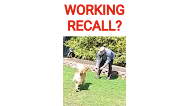Reinforcement and Punishment - The "positives" and the "negatives"
Positive Reinforcement:
- Positive reinforcement involves giving something pleasant or desirable to increase the likelihood of a behavior happening again.
- For a dog, this could mean giving treats, praise, or belly rubs when they perform a desired behavior.
- For example, if you want to teach your dog to sit, every time they sit when you ask, you give them a treat. Eventually, they'll learn that sitting leads to getting treats, so they'll be more likely to sit in the future.
Negative Reinforcement:
- Negative reinforcement involves removing something unpleasant or aversive to increase the likelihood of a behavior happening again.
- For a dog, this could mean stopping an unpleasant sound or sensation when they perform a desired behavior.
- For example, if you're teaching your dog to come when called, you might stop tugging on their leash as soon as they start coming towards you. The removal of the uncomfortable sensation of being tugged encourages them to come to you more often in the future.
Positive Punishment:
- Positive punishment involves adding something unpleasant or aversive to decrease the likelihood of a behavior happening again.
- For a dog, this could mean giving a sharp verbal reprimand or using a spray bottle to discourage unwanted behavior.
- For example, if your dog jumps on people, you might say "No!" firmly every time they do it. The unpleasantness of the verbal reprimand makes them less likely to jump on people in the future.
Negative Punishment:
- Negative punishment involves removing something pleasant or desirable to decrease the likelihood of a behavior happening again.
- For a dog, this could mean taking away a toy or ending playtime when they engage in unwanted behavior.
- For example, if your dog is playing too roughly and bites too hard, you might stop playing and walk away. The removal of the enjoyable playtime teaches them that biting too hard leads to the fun ending.
Remember, the effectiveness of these techniques depends on the individual dog and the situation, so it's essential to use them carefully and appropriately.


Comments
Post a Comment